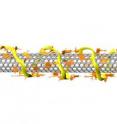Armchair science: DNA strands that select nanotubes are first step to a practical 'quantum wire'
DNA, a molecule famous for storing the genetic blueprints for all living things, can do other things as well. In a new paper,* researchers at the National Institute of Standards and Technology (NIST) describe how tailored single strands of DNA can be used to purify the highly desired "armchair" form of carbon nanotubes. Armchair-form single wall carbon nanotubes are needed to make "quantum wires" for low-loss, long distance electricity transmission and wiring. Single-wall carbon nanotubes are usually about a nanometer in diameter, but they can be millions of nanometers in length. It's as if you took a one-atom-thick sheet of carbon atoms, arranged in a hexagonal pattern, and curled it into a cylinder, like rolling up a piece of chicken wire. If you've tried the latter, you know that there are many possibilities, depending on how carefully you match up the edges, from neat, perfectly matched rows of hexagons ringing the cylinder, to rows that wrap in spirals at various angles—"chiralities" in chemist-speak.
Chirality plays an important role in nanotube properties. Most behave like semiconductors, but a few are metals. One special chiral form—the so-called "armchair carbon nanotube"**—behaves like a pure metal and is the ideal quantum wire, according to NIST researcher Xiaomin Tu.
Armchair carbon nanotubes could revolutionize electric power systems, large and small, Tu says. Wires made from them are predicted to conduct electricity 10 times better than copper, with far less loss, at a sixth the weight. But researchers face two obstacles: producing totally pure starting samples of armchair nanotubes, and "cloning" them for mass production. The first challenge, as the authors note, has been "an elusive goal."
Separating one particular chirality of nanotube from all others starts with coating them to get them to disperse in solution, as, left to themselves, they'll clump together in a dark mass. A variety of materials have been used as dispersants, including polymers, proteins and DNA. The NIST trick is to select a DNA strand that has a particular affinity for the desired type of nanotube. In earlier work,*** team leader Ming Zheng and colleagues demonstrated DNA strands that could select for one of the semiconductor forms of carbon nanotubes, an easier target. In this new paper, the group describes how they methodically stepped through simple mutations of the semiconductor-friendly DNA to "evolve" a pattern that preferred the metallic armchair nanotubes instead.
"We believe that what happens is that, with the right nanotube, the DNA wraps helically around the tube," explains Constantine Khripin, "and the DNA nucleotide bases can connect with each other in a way similar to how they bond in double-stranded DNA." According to Zheng, "The DNA forms this tight barrel around the nanotube. I love this idea because it's kind of a lock and key. The armchair nanotube is a key that fits inside this DNA structure—you have this kind of molecular recognition."
Once the target nanotubes are enveloped with the DNA, standard chemistry techniques such as chromatography can be used to separate them from the mix with high efficiency.
"Now that we have these pure nanotube samples," says team member Angela Hight Walker, "we can probe the underlying physics of these materials to further understand their unique properties. As an example, some optical features once thought to be indicative of metallic carbon nanotubes are not present in these armchair samples."
Source: National Institute of Standards and Technology (NIST)
Other sources
- Armchair science: DNA strands that select nanotubes are first step to a practical 'quantum wire'from Science DailyWed, 3 Aug 2011, 15:30:35 UTC
- DNA strands that select nanotubes are first step to a practical 'quantum wire'from PhysorgWed, 3 Aug 2011, 14:30:55 UTC
